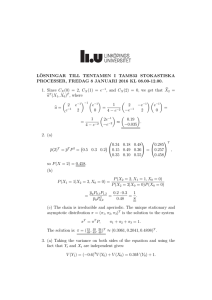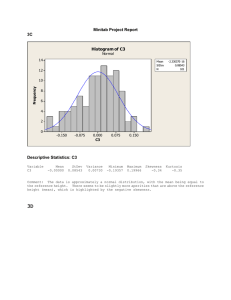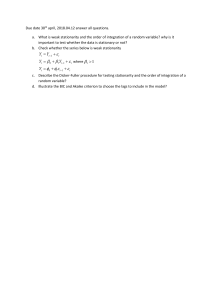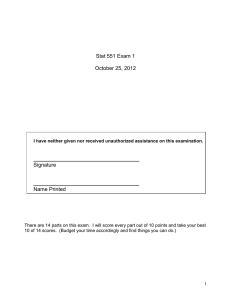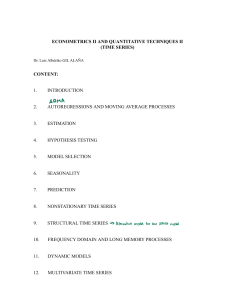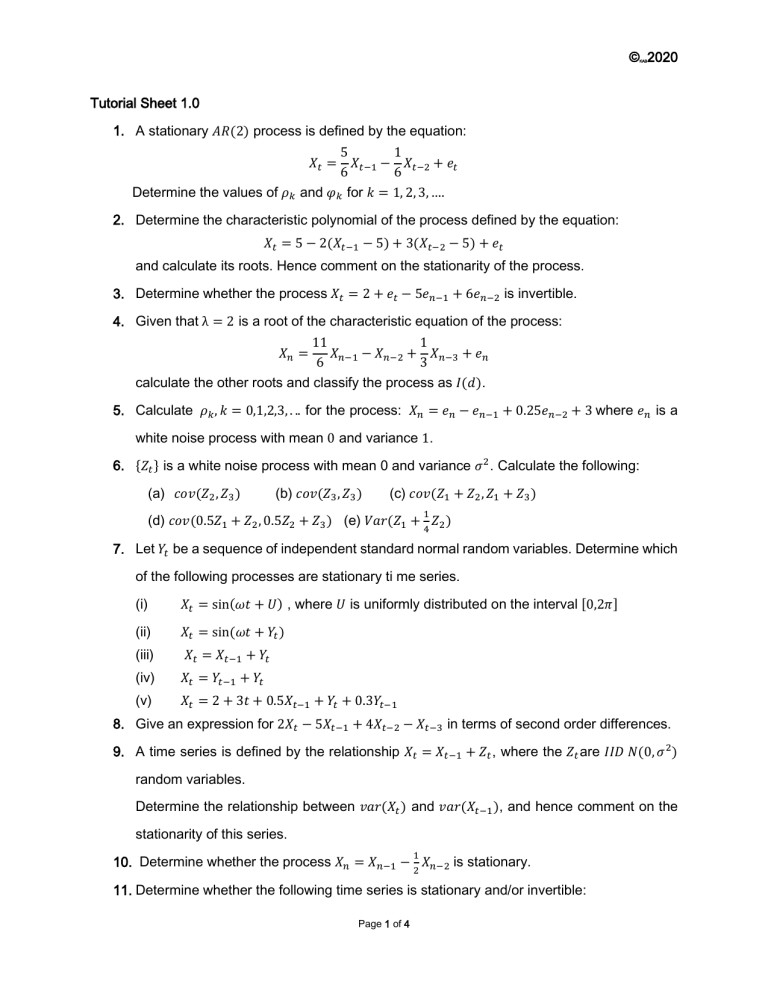
© 2020
KAB
Tutorial Sheet 1.0
1. A stationary 𝐴𝑅(2) process is defined by the equation:
5
1
𝑋𝑡 = 𝑋𝑡−1 − 𝑋𝑡−2 + 𝑒𝑡
6
6
Determine the values of 𝜌𝑘 and 𝜑𝑘 for 𝑘 = 1, 2, 3, ….
2. Determine the characteristic polynomial of the process defined by the equation:
𝑋𝑡 = 5 − 2(𝑋𝑡−1 − 5) + 3(𝑋𝑡−2 − 5) + 𝑒𝑡
and calculate its roots. Hence comment on the stationarity of the process.
3. Determine whether the process 𝑋𝑡 = 2 + 𝑒𝑡 − 5𝑒𝑛−1 + 6𝑒𝑛−2 is invertible.
4. Given that λ = 2 is a root of the characteristic equation of the process:
11
1
𝑋𝑛−1 − 𝑋𝑛−2 + 𝑋𝑛−3 + 𝑒𝑛
6
3
calculate the other roots and classify the process as 𝐼(𝑑).
𝑋𝑛 =
5. Calculate 𝜌𝑘 , 𝑘 = 0,1,2,3, . .. for the process: 𝑋𝑛 = 𝑒𝑛 − 𝑒𝑛−1 + 0.25𝑒𝑛−2 + 3 where 𝑒𝑛 is a
white noise process with mean 0 and variance 1.
6. {𝑍𝑡 } is a white noise process with mean 0 and variance 𝜎 2 . Calculate the following:
(a) 𝑐𝑜𝑣(𝑍2 , 𝑍3 )
(b) 𝑐𝑜𝑣(𝑍3 , 𝑍3 )
(c) 𝑐𝑜𝑣(𝑍1 + 𝑍2 , 𝑍1 + 𝑍3 )
1
(d) 𝑐𝑜𝑣(0.5𝑍1 + 𝑍2 , 0.5𝑍2 + 𝑍3 ) (e) 𝑉𝑎𝑟(𝑍1 + 4 𝑍2 )
7. Let 𝑌𝑡 be a sequence of independent standard normal random variables. Determine which
of the following processes are stationary ti me series.
(i)
𝑋𝑡 = sin(𝜔𝑡 + 𝑈) , where 𝑈 is uniformly distributed on the interval [0,2𝜋]
(ii)
𝑋𝑡 = sin(𝜔𝑡 + 𝑌𝑡 )
(iii)
𝑋𝑡 = 𝑋𝑡−1 + 𝑌𝑡
(iv)
𝑋𝑡 = 𝑌𝑡−1 + 𝑌𝑡
(v)
𝑋𝑡 = 2 + 3𝑡 + 0.5𝑋𝑡−1 + 𝑌𝑡 + 0.3𝑌𝑡−1
8. Give an expression for 2𝑋𝑡 − 5𝑋𝑡−1 + 4𝑋𝑡−2 − 𝑋𝑡−3 in terms of second order differences.
9. A time series is defined by the relationship 𝑋𝑡 = 𝑋𝑡−1 + 𝑍𝑡 , where the 𝑍𝑡 are 𝐼𝐼𝐷 𝑁(0, 𝜎 2 )
random variables.
Determine the relationship between 𝑣𝑎𝑟(𝑋𝑡 ) and 𝑣𝑎𝑟(𝑋𝑡−1 ), and hence comment on the
stationarity of this series.
1
10. Determine whether the process 𝑋𝑛 = 𝑋𝑛−1 − 2 𝑋𝑛−2 is stationary.
11. Determine whether the following time series is stationary and/or invertible:
Page 1 of 4
© 2020
KAB
𝑋𝑡 − 0.1𝑋𝑡−1 + 0.2𝑋𝑡−2 = 𝑍𝑡 + 0.2𝑍𝑡−1
where {𝑍𝑡 } represents a set of uncorrelated random variables with mean 0 and variance
𝜎 2.
12. An autoregressive stationary time series 𝑊𝑡 is defined by the relationship:
𝑊𝑡 = 0.6𝑊𝑡−1 + 0.4𝑊𝑡−2 − 0.1𝑊𝑡−3 + 𝑍𝑡
for integer times 𝑡, where {𝑍𝑡 } represents a set of uncorrelated random variables with
mean 0 and variance 𝜎 2 .
(i)
Explain why 𝑐𝑜𝑣(𝑊𝑡 , 𝑍𝑡+1 ) = 0 and 𝑐𝑜𝑣(𝑊𝑡−1 , 𝑊𝑡 ) = 𝑐𝑜𝑣(𝑊𝑡−1 , 𝑊𝑡−2 ).
(ii)
By considering 𝑐𝑜𝑣(𝑊𝑡 , 𝑊𝑡−𝑘 ).when 𝑘 = 0,1,2,3, write down a set of four equations
relating the values of the autocovariance function 𝛾𝑘 at lags 𝑘 = 0,1,2,3,.
(iii)
Solve the four equations in part (ii) to find both the autocovariance function and the
autocorrelation function for lags 0, 1, 2 and 3.
13. Calculate the autocorrelation function of the process 𝑋𝑛 = 1 + 𝑒𝑛 − 5𝑒𝑛−1 + 6𝑒𝑛−2 .
14. (i) The first differences of a time series 𝑋 can be modelled by the process:
∇𝑋𝑛 = 0.5∇𝑋𝑛−1 + 𝑒𝑛
Determine the model for 𝑋𝑛 .
(ii) Show that the process 𝑋𝑛 is non-stationary.
15. (i) Show that the relationship 𝑌𝑡 = 0.7𝑌𝑡−1 + 0.3𝑌𝑡−2 + 𝑍𝑡 + 0.7𝑍𝑡−1 . (where the 𝑍’𝑠 denote
white noise) defines an 𝐴𝑅𝐼𝑀𝐴(1,1,1) process.
(ii) Show carefully that the relationship 𝑆𝑡 = 1.5𝑆𝑡−1 + 0.3𝑆𝑡−3 + 𝑍𝑡 + 0.5𝑍𝑡−1 cannot be
expressed as an 𝐴𝑅𝐼𝑀𝐴(1,2,1) process.
16. Consider the process with defining equation: 𝑋𝑛 = 5𝑋𝑛−1 − 0.4𝑋𝑛−2 + 𝑋𝑛−3 + 𝑒𝑛
Write this as a vector process that possesses the Markov property.
17. Let 𝑋𝑛 = 𝑒𝑛 + 𝑒𝑛−2 be an 𝑀𝐴(2) process where 𝑒𝑛 ~𝑁(0,1).
(i)
Calculate 𝑃(𝑋𝑛 ≥ 0|𝑋𝑛−1 ≤ 0)
(ii)
Compare your answer to (i) with 𝑃(𝑋𝑛 ≥ 0|𝑋𝑛−1 ≤ 0, 𝑋𝑛−2 ≤ 0)and hence comment on
whether the process is Markov.
18. Calculate the values of 𝜌1 and 𝜌2 , the autocorrelation function at lags 1 and 2, for the
stationary 𝐴𝑅(2) process defined by the equation:
𝑋𝑛 = −0.8𝑋𝑛−1 + 0.1𝑋𝑛−2 + 𝑒𝑛
Page 2 of 4
© 2020
KAB
19. Consider the time series model defined by:
𝑋𝑡 = 𝛼1 𝑋𝑡−1 + 𝛼2 𝑋𝑡−2 + 𝛼3 𝑋𝑡−3 + 𝑒𝑡
where 𝑒𝑡 is white noise.
(i)
Show that the autocorrelation coefficient with lag 1 for this process is:
𝛼1 + 𝛼2 𝛼3
𝜌1 =
1 − 𝛼2 − 𝛼1 𝛼3 − 𝛼32
(ii)
Consider the case where 𝛼1 = 𝛼2 = 𝛼3 = 0.2.
(a) Comment on the stationarity of this model.
𝐻𝑖𝑛𝑡: 5 − 𝑥 − 𝑥 2 − 𝑥 3 ≈ (1.278 − 𝑥)(3.912 + 2.278𝑥 + 𝑥 2 )
(b) Calculate 𝜌1 and 𝜌2 ,
(c) Calculate the partial autocorrelation coefficients 𝜑1 and 𝜑2 ,
(d) Sketch correlograms of the autocorrelation function and the partial autocorrelation
function. (You are not required to calculate the coefficients for higher lags.)
20. {𝑋𝑡 } is a stationary 𝐴𝑅𝑀𝐴(1,2) time series defined at integer times by the relationship:
𝑋𝑡 = 𝛼𝑋𝑡−1 + 𝑍𝑡 + 𝛽𝑍𝑡−2
where 𝛼, 𝛽 are constants and {𝑍𝑡 } is a purely random process with mean 0 and constant
variance 𝜎 2 .
(ii)
Define the term ‘weakly stationary process’.
(iii)
Assuming that the above process has a very long history, state the conditions on
𝛼 and 𝛽 needed to ensure that it is:
(a) Stationary
(b) Invertible.
(iv)
Show that for any integer 𝑠:
𝑐𝑜𝑣(𝑋𝑠 , 𝑍𝑠 ) = 𝜎 2
(v)
𝑐𝑜𝑣(𝑋𝑠 , 𝑍𝑠−1 ) = 𝛼𝜎 2 𝑐𝑜𝑣(𝑋𝑠 , 𝑍𝑠−2 ) = (𝛼 2 + 𝛽)𝜎 2
(a) By considering 𝑐𝑜𝑣(𝑋𝑡 , 𝑋𝑡 ), 𝑐𝑜𝑣(𝑋𝑡 , 𝑋𝑡−1 ) and 𝑐𝑜𝑣(𝑋𝑡 , 𝑋𝑡−2 ), write down three
equations involving 𝛾0 , 𝛾1 and 𝛾2 .
(b) Hence find expressions for 𝛾0 , 𝛾1 and 𝛾2 in terms of the parameters 𝛼, 𝛽 and
𝜎 2.
Page 3 of 4
© 2020
KAB
(vi)
(a) Calculate the values of 𝜌0 , 𝜌1 , 𝜌2 and 𝜌3 in the case where 𝛼 = −0.4 and 𝛽 =
−0.9.
(b) Hence sketch a graph of the autocorrelation function 𝜌𝑘 for lags 𝑘 = 0, 1, 2, … , 10
in this case.
……
Page 4 of 4
